Sure, there’s a lot of entertainment value in grand set piece battles, personal duels, or even two wizards engaging in a magical combat to the death. But there are those of us who enjoy a more arcane pleasure: edge of the seat thrills as protagonists struggle to build vast infrastructure projects. I would argue that providing London with a functional sewer system was more exciting than defeating the French at Trafalgar. Why read Riders of the Purple Sage when the same author wrote what is, to my mind at least, a much more engaging book: Boulder Dam, a thrilling historical account of the building of the dam!
A few other SFF authors have embraced the romance of large-scale engineering projects. Here are five inspirational examples.
A Transatlantic Tunnel, Hurrah! by Harry Harrison (1972)

The traitor George Washington is almost two centuries dead. The once rebellious colonies are now content within the British Empire. The Atlantic still divides the imperial children from their doting British mother. It falls to Washington’s descendant Captain Augustine Washington, to tether Britain to America with nothing less than a transatlantic tunnel! Hurrah!
Many might (and many have) expected Augustine to be a bad seed, carrying as he does within his veins the blood of one of history’s greatest villains. Nevertheless, Augustine is a dutiful subject and a superlative engineer. He is highly motivated. Not just by patriotism, but by passion of a more personal variety. Completing the tunnel will not merely unify an empire; it may win him the hand of the woman he loves.
***
The Complete Venus Equilateral by George O. Smith (19761)
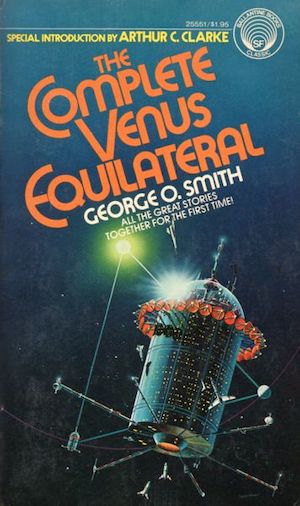
Located sixty degrees ahead of Venus, the Venus Equilateral Relay Station and the three thousand people working within the converted asteroid are a critical element in interplanetary communications. Without Venus Equilateral, contact between Earth and Venus would be disrupted whenever orbital dynamics placed the Sun too close to line of sight between the worlds. With Venus Equilateral, messages can flow back and forth without interruption. The station’s services are indispensable.
One might expect therefore that Venus Equilateral would be sacrosanct, spared the machinations of the ambitious. Not so! The hard-working engineers and the women to whom they explain things at great length are forever defending Venus Equilateral from officious bureaucrats, would-be space pirates, and not least, the hard-working engineers themselves, none of whom ever pause for consideration before unleashing their latest paradigm-breaking inventions on a poorly prepared world.
***
The Outskirter’s Secret by Rosemary Kirstein (1992)
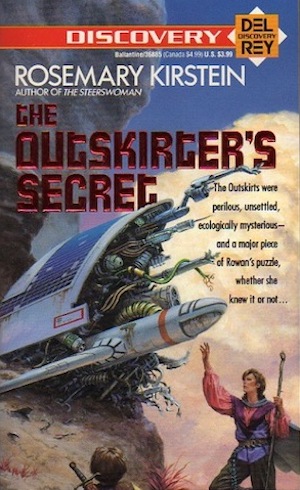
At first glance, Steerswoman Rowan lives in a fantasy world, one in which the common folk depend on lore gathered and disseminated by a guild of Steerswomen. They are also subject to the whims of powerful, aloof wizards. Wizards and Steerswomen do not mix.
Readers eventually learn that this is no fantasy world. The Steerswomen are busy creating pure science from scratch. The wizards in contrast might be called “engineers,” shaping their world with applied sciences whose basis they do not completely understand and which they will not share with others.
Although Rowan is not aware of the fact, her world is the stage for a centuries-long project, an epic struggle to reshape a world. A few hints have fallen into Rowan’s hands, enough to lure her out into the Outskirts where human-compatible organisms rub shoulders with biochemically incompatible plants and animals. The quest should be straightforward. After all, how dangerous could the innocuously named “Routine Bioform Clearance” be?
***
The Collapsium by Wil McCarthy (2002)
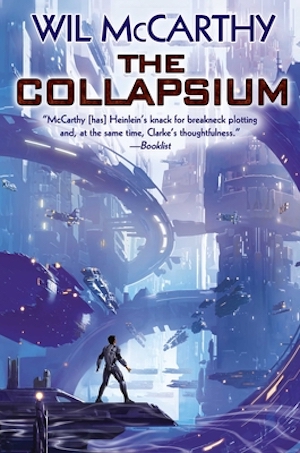
The Ring Collapsiter exploits certain useful properties of hyperdense matter to provide humanity with superluminal, high-bandwidth communication across the inner Solar System. There is but one small flaw in the system, the very one that compels Her Majesty Tamra-Tamatra Lutui, the Virgin Queen of All Things, to visit a scientist’s isolated Kuiper Belt retreat.
As long as the Ring Collapsiter functions properly, all is well. Should something – a natural mishap like a flare, perhaps, or deliberate sabotage – disrupt the systems holding the ring in place above the Sun, all is somewhat less well. If the hyperdense collapsium in the ring fell into the Sun, the side-effects could well exterminate life across the Solar System. This would be bad. Accident and malice are inevitable. It falls to scientist Bruno to prevent doomsday.
***
The Man Who Bridged the Mist by Kij Johnson (2011)
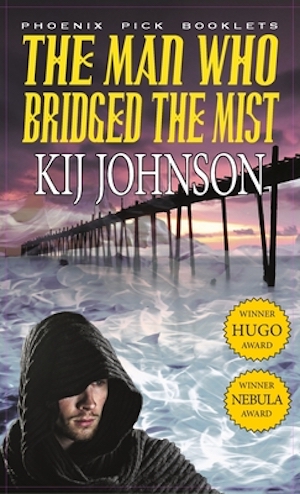
Bridging the wide river that divides the Empire’s Nearside from Farside would be challenge enough were it to span a conventional river. In this case, the river is concealed within a caustic mist. If that were not enough, creatures, some quite massive, lurk within the mists. Each trip across the river is a calculated risk.
Kit Meinem of Atyar has been tasked to build a bridge over the river. The project will take years, long enough for Kit to get to know and become fond of the people on either side of the river. It was one thing to plan the bridge without knowing those it would affect; it’s quite another when you know the people who will lose their livelihood. Especially when some of those people are friends and lovers.
***
No doubt you have your own favourites, many of which you feel are vastly superior to the ones I selected. Comments are below.
[1]The publication date is misleading. Of the thirteen stories in the collection, twelve date from the 1940s, and one from the 1970s. However, they were not all collected in the same volume until the mid-1970s.










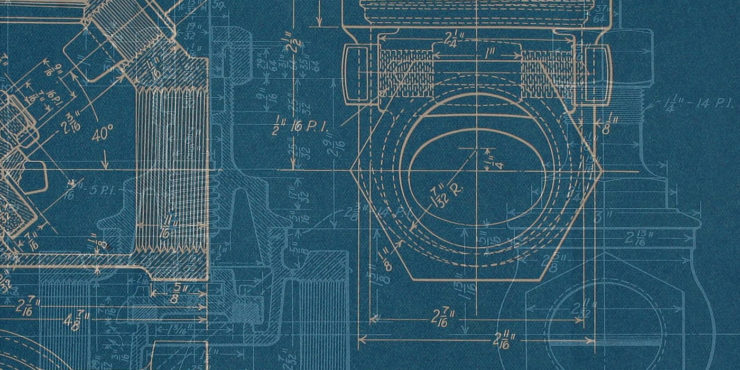
Arthur C. Clarke’s The Fountains of Paradise. Contains much planning of the geosynchronous space elevator, and also – in the project’s architect, Vannevar Morgan – a Clarke protagonist with enough of a personality that I can actually remember his name.
I fondly remember Venus Equilateral from my childhood, I do wonder how well it holds up.
Venus Equilateral is extremely 1940s, minus any hint of WWII. That said, the story where two guys trash an electrical grid because the documentation for the device they are playing with is crap aged well.
I’m put in mind of the comedy sketch wherein the construction of a Transatlantic Bridge is halted midway by a lack of funding. The solution? Open the side of the bridge already attached to land to start collecting tolls. The engineer explaining this stands close enough to the uncompleted side of the bridge that we can hear regular splashes in the background…
It amuses me because I regularly cross a bridge which forks off in two directions and I believe was at one point intended to have a third- which as it stands just sort of stops, although in this case the folks responsible have helpfully put up a concrete barrier.
The Collapsium is one of my favorite books. A very fun story as Bruno whips together tech to stave off disaster. The sequels are interesting, but much darker.
When I was a kid, maps of Waterloo showed an aspirational extension of Westmount. That stretch of the road did not exist and would not for some time but for some reason locals were determined to assure drivers it would exist at some point in the future.
More alarmingly, there was a public bridge near our farm that had a “under repair: cross at own risk” sign the entire time we owned that farm. Never saw anyone work on that bridge.
Kim Stanley Robinson’s entire oeuvre features titanic feats of extreme engineering. The Martian Space Elevator in the Mars trilogy is a colossal plot point. There is the roving mobile city on Mercury and the very seldom-explored Venusian terraforming idea also very central to storyline(s) in 2312* (plus the terrarium cities of the asteroid belt, and the submerged cities on earth).
* If terraforming on Mars is called ‘aeroforming’ what would it be on Venus? aphrosiaforming?)
@7- I’ll admit my Latin’s not all that, but I always read Terraforming as the process of making a planet more earthlike, in which case Aphrosiaforming (or Veneraforming?) would be to alter a planet to be more like Venus, which is liable to cause complaints from the locals.
An earlier work about a transatlantic tunnel is the 1935 film “The Tunnel”, which juxtaposes relationship drama, man versus the elements, world peace which the tunnel will bring about (somehow) versus Merchants of Death, and some nice mostly reasonably conservative (if not all fulfilled) sfnal elements.
Beyond the “radium drill” and “Allenite steel” that make the tunnel possible, over the decades of its construction we see television, videophones, new aircraft, etc. make their appearance. Also, in an unusual nod to accessibility, a motorized wheelchair.Even before completion the tunnel has brought about a union of the US and UK, with giant screens in the houses allowing Congress and Parliament to confer.
https://en.m.wikipedia.org/wiki/The_Tunnel_(1935_film)
Technically, the novel The Next Continent by Issui Ogawa, covers the construction of a Lunar hotel near the poles. Much of the novel covers the machinations and construction of the necessary infrastructure needed to support such an endeavor.
The Transatlantic Tunnel Hurrah has a doozy of a continuity error – early in the work, we learn that there have been problems with the “Spanish colonies” in North America, but late in the work, we read that Spain and Spainish are words unknown in this history.
Graydon Saunders A Series of Very Bad Days does get into that. What happens when you take dangerously powerful sorcerers, teach them and aim them at civil works projects? Quite a lot.
I think I read an excerpt of the Kij Johnson story, and now I have to go find the whole thing. Thanks!
Colin Kapp’s The Unorthodox Engineers is a collection of short stories where the titular engineers have to find ways around technical issues like “this planet has volcanoes constantly erupting at random locations build us a railway”, “gravity on this particular planet occasionally decides to work sideways” and “hey we want to study this black hole build us a lab it can’t eat”.
My recollections of “Venus Equilateral” have the stories as not much about its physical construction, more about its operation as a moneymaking business. It’s a crewed space station that exchanges radio beams with the inhabited planets of the Solar System more reliably than if they have to beam each other directly, so there is a sort of a structure of beam paths from place to place, but I think it’s just electromagnetic waves and maybe other mysterious rays, nothing solid, nothing fixed? The other thing I remember is a compartment labelled “air plant” which appeared to be farming weeds. I suppose it was 1940s that they weren’t tested pharmacologically upon being found.
See, this is why I have to read JDN’s posts, even when they concern subjects of little inherent interest to me. “The hard-working engineers and the women to whom they explain things at great length” gave me my best laugh of the day.
The Transatlantic Tunnel was the first Harry Harrison I read, and I remember waiting anxiously for each installment in the serial to arrive. Heinlein’s “The Roads Must Roll” is another infrastructure-based story. And the gigantic ring around the world in Neal Stephenson’s Seveneves is certainly an audacious achievement.
Does Harrison explain how the tunnellers deal with the volcanism of the mid-Atlantic ridge?
@19 Verisimilitude was not high on his list of things to accomplish with that book.
When I read it A Fall of Moondust seemed quite technically exciting. Accurate, I’m not so sure.
L. Sprague de Camp’s “Viagens” series was collected in a book called The Continent Makers and other stories. I think it qualifies.
@@.-@: which bridge? Just north of Boston there is an elevated highway with a number of stubs to/from nowhere — because somebody realized (i.e., had it pounded into them like a UU student trying to sneak a book past the Librarian) that the inner beltway the stubs would connect to would ruin tens of thousands of lives AND run through an area prone to heavy fog.
@6: I thought you lived in Canada, not Connecticut! (Much of the Connecticut segment of the inland highway between New York and Boston was posted as ~”Legally Closed — proceed at your own risk” for decades. I don’t remember any work being done there either.)
@15: “air plant” was just that — something that was supposed to turn CO2 into oxygen very effectively. This was a trope of SF for decades before writers looked at how plants actually worked. The one person who mistook the plants for weeds was a suit who nearly killed everyone on the station by tearing them out without telling anyone.
@16,
I agree!
There’s an in-universe example of this in Bujold’s Falling Free: the Quaddies are taught the history of engineering and technology, but not about wars and revolutions and so on.
The most amusing “SF infrastructure” example is the Los Angeles Subway, which was predicted in Niven and Pournelle’s Oath of Fealty and then actually built. No apartment building with quarter of a million residents yet.
Rick Raphael’s Code Three sort of qualifies – it’s a novel about the police who patrol a giant superhighway that runs from Alaska to (I think) Mexico, with speeds of several hundred MPH common. A fair chunk of the story is how the system works, and why it’s running into serious problems as vehicle speeds increase.
Raphael did some other infrastructure type stories – one about the interstellar postal service, one about water management in an overpopulated USA, and so forth. The important books for him are Code Three (1966), a fix-up of three stories in the superhighway setting, and The Thirst Quenchers (1965), an anthology of 4 novelettes. There apparently was another anthology of his work after his death, The Thirst Quenchers and Three Other Science Fiction Tales (2010) but it omits the other stories from the 1965 collection – don’t know what replaced them.
Sadly there are no two-fisted engineering stories about the race to build the first Nicoll-Dyson laser in the Galaxy and thus prevent anyone else building a runner-up.
Colin Kapp’s Cageworld series posited a lot of Very Big Tech with the planets of the Solar System running in circularised orbits, constrained by giant ball-bearing cages.
Glad to see The Steerswoman & KSR’s Mars triology.
Ones where engineering in every nut, bolt, weld and whatnot is an inherent part of the story is Modesitt’s series, especially The Magic Engineer. Other books have building complexes, ports, harbours, transport, etc as integral part of the plots
C. Dale Brittain’s A Bad Spell in Yurt has the wizard Daimbert tasked with creating a telephone system in the titular kingdom. I will second #27’s note about Modesitt’s Recluce books, as well.
There are bound to be others, but I can’t think of any that others will appreciate.
(Now, Edmond Hamilton (I think), writing under the name Brett Stirling, wrote a book called The Tenth Planet, in which Captain Future attempts to help keep the creation of a new planet on track…. No?)
@28: I stand corrected. Hamilton wrote most of the Captain Future books, but William Morrison, under the name Brett Sterling (not “Stirling,” as I wrote above), wrote two of them. Manly Wade Wellman wrote another two, I think.
@24, Gareth: Falling Free really is an ode to engineering in general and I quite like that about it. The back half of the book particularly has what I would qualify as a major infrastructure challenge, even.
Heck, it’s even got an engineer punching out his manager boss, and isn’t that what this genre of story is *really* all about?
@30 One thing that stuck with me from Falling Free is when it said a competent engineer will save far more lives than any doctor. It’s just that things not blowing up and killing hundreds of people doesn’t attract much attention.
I started to read the comments fearing someone would bring up KSR. Scarred by his lazy and ridiculous treatment of underwater physics in his soggy NYC book. Nope. I wouldn’t trust any of his engineering any more than I’d want to go back in time and drive across the old Takoma Narrows Bridge in a wind storm
It’s not quite in the theme of infrastructure, but Andy Weir’s The Martian is definitely about space engineering, even if it’s mostly about taking meticulously planned infrastructure and using it for things it was never designed for.
@31: My own personal highlight is the lecture on engineering ethics. That should be taught as part of the text in actual ethics in engineering classes, because it is a master-class on why integrity in your work is of the highest importance.
@34: Yes. Leo’s lecture is wonderful.
This is so great, thank you!
I’ve published open-access academic articles on infrastructure sf — in Chinese fiction by Hao Jingfang and Liu Cixin as well as the short story “Covehithe” by China Mieville.
https://c21.openlibhums.org/article/id/594/
https://www.alluvium-journal.org/2019/07/01/infrastructural-futures-in-chinese-science-fiction/
The opening book of James Blish’s ‘Okie’ series, CITIES IN FLIGHT seems to qualify, even if The Bridge on Jupiter was a bridge to nowhere…
The underground tube transportation system is crucial to finding the metallic hydrogen McGuffin in Tony Rothman’s “The World is Round.” It’s a marvelous out of print Planet of Mystery story from the early ’80s. There’s a lot there including the transition from the Middle Ages to the Renaissance. The characters are well drawn and include a cynical protagonist and Newton and Galileo analogues.
The QSE portals in Peter F. Hamilton’s Salvation Sequence books are essential to the story – enabling limitless power via solar plasma, connecting future-humanity’s myriad worlds, etc. They would not be the same books without that technology.
I read this when really young but still remember it even before Venus Equilateral. (Space grass, LoL) The book was Space Platform by Murray Leinster. It was one of the ones I enjoyed from my Dad’s shelves.
Upvote for the excellent Steerswoman books by Rosemary Kirstein! Still faithfully waiting for the next ones!
Bujold’s Falling Free comes to mind – fabulous engineering project along with some fine worldbuilding!
Did the Steerswoman series ever get finished? I don’t see anything since 2004… (she’s still alive, so there’s still hope…)
I’m very fond of these infrastructure-type stories — even did a blog post on the subject.
Heinlein’s Farmer in the Sky is all about terraforming — that’s where I got my appreciation for worms and insects and other humble factors in a whole ecology.
For a more recent one, how about Larry Niven & Brenda Cooper’s Building Harlequin’s Moon? They’re actually building a habitable moon from scratch — just to facilitate continuation of an interstellar voyage.
“Step to the Stars” by Del Rey – first space station (and evil enemies from “The Combine”)
@17 – I came to comment just Stephenson’s works. Every one of his titles do justice to the intention of mega-engineering, with ‘Seveneves’ being somewhat a crowning achievement. I love his writing – I just wish he would stop dropping the finish. :P
The first book I thought of when I read this headline was Niven’s Ringworld. There is even a sequel called The Ringworld Engineers. . . .
I haven’t read it in ages and suspect it holds up not at all well (in fact, I think it’s where I learned that “bird” is sometimes slang for “woman”), but I adored Venus Equilateral in my teens, and had the paperback with the cover pictured in the article.
No Pratchett yet? I’ve read very little of his work, but surely Going Postal counts.
Becky Chambers’s The Long Way to a Small, Angry Planet is about a spaceship crew whose job is to make stable wormholes–in essence, to build interstellar highways.
Peter Watts Island (?) short story and Freeze frame revolution.
I would have to vote for Asimov’s The Gods Themselves. The engineering project here spans multiple dimensions and is one of the few chemistry SF concepts. It also has one of the most interesting alien species I’ve ever read about. As a second place vote, I have always wondered if the Vogons will ever finish their hyperspace bypass network . . .
It’s not exactly infrastructure, but The Engineer trilogy by K. J. Parker (Devices and Desires, Evil for Evil, and The Escapement) has a lot of engineering of weapons and walls and just putting stuff together. Since the main hero/villain is an engineer.
Eric Flint and Dave Freer’s 163x series has many examples of large scale infrastructure in less than stellar conditions. My favorite parts of the book(s) involve some MacGuyver-ing of 20th century tech with 17th century materials.
Another book with infrastructure as a major character is Mercedes Lackey’s Mage Storms trilogy. Duke Tremaine is just doing his best to infrastructure his way out of a death trap for him and his men.
Well, I’m embarrassed that I didn’t think of this at all. But the original of James White’s Sector General stories, Hospital Station, as well as some of the sequels, were quite a bit about infrastructure, at least the infrastructure of a gigantic multi-species hospital.
Those, like so many other good books I have, are probably due for a re-read.
@50 John D. Clark’s _Ignition! An informal History of Liquid Rocket Propellants_ would count as fiction about chemistry, except that, horrifyingly, it’s not fictional. (I have always wondered just how much more terrifying the rumoured classified version might be.)